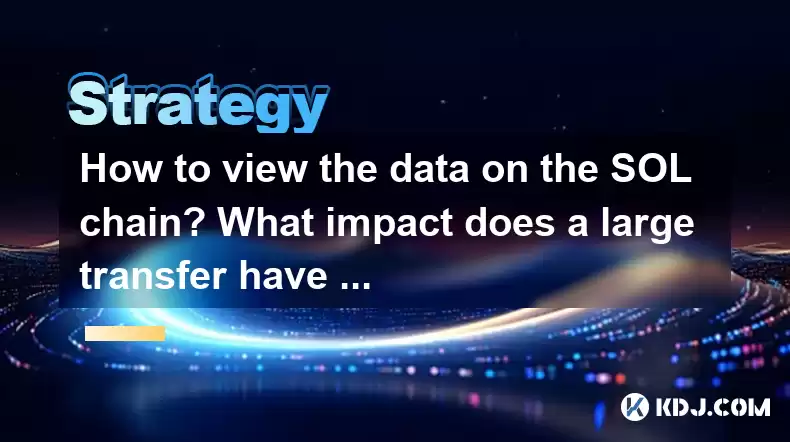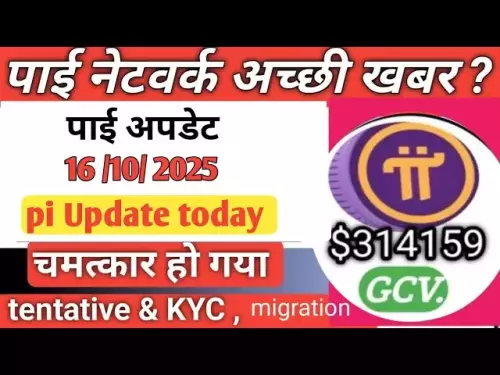-
 bitcoin
bitcoin $110918.433029 USD
-1.69% -
 ethereum
ethereum $3996.872473 USD
-2.43% -
 tether
tether $1.000594 USD
0.00% -
 bnb
bnb $1178.871834 USD
-2.38% -
 xrp
xrp $2.413973 USD
-3.47% -
 solana
solana $194.341461 USD
-4.24% -
 usd-coin
usd-coin $0.999963 USD
-0.03% -
 tron
tron $0.320092 USD
0.92% -
 dogecoin
dogecoin $0.196919 USD
-3.42% -
 cardano
cardano $0.669585 USD
-3.63% -
 hyperliquid
hyperliquid $37.485952 USD
-3.58% -
 ethena-usde
ethena-usde $1.000026 USD
-0.02% -
 chainlink
chainlink $18.018220 USD
-5.13% -
 bitcoin-cash
bitcoin-cash $523.879267 USD
-2.41% -
 stellar
stellar $0.324655 USD
-3.67%
How to view the data on the SOL chain? What impact does a large transfer have on the price?
Large transfers on the SOL chain can signal price movements; use tools like Solana Explorer to monitor and analyze these transactions for market insights.
Apr 28, 2025 at 03:00 pm

Introduction to Viewing SOL Chain Data
Understanding the Solana blockchain, often referred to as the SOL chain, involves delving into its public ledger, which records all transactions and other relevant data. This information is critical for anyone interested in the cryptocurrency space, whether you are an investor, developer, or enthusiast. To view data on the SOL chain, various tools and platforms are available that provide comprehensive insights into transactions, account balances, and network performance.
Tools for Viewing SOL Chain Data
Several tools are specifically designed to help you navigate and analyze data on the Solana blockchain. Solana Explorer is one of the most popular and user-friendly options. It provides a detailed view of transactions, accounts, and blocks on the Solana network. Another tool, Solana Beach, offers real-time data and analytics, which can be invaluable for those looking to understand the current state of the blockchain.
- Visit the Solana Explorer website.
- Enter the address or transaction hash you want to look up in the search bar.
- Click on the search icon to view detailed information about the transaction or account.
For those interested in more advanced analytics, SolanaFM provides a dashboard with real-time metrics and historical data, making it easier to track the performance of the Solana network over time.
Understanding Large Transfers on the SOL Chain
Large transfers on the SOL chain, often involving significant amounts of SOL or other tokens built on the Solana network, can have various implications. These transfers can be between wallets, from exchanges to wallets, or vice versa. Understanding these transfers is crucial for assessing market sentiment and potential price movements.
Impact of Large Transfers on SOL Price
Large transfers can influence the price of SOL in several ways. When a large amount of SOL is moved from an exchange to a private wallet, it might be interpreted as a sign of long-term holding, potentially reducing the immediate selling pressure and positively affecting the price. Conversely, if a large transfer is seen moving from a private wallet to an exchange, it could signal an intent to sell, which might lead to an increase in selling pressure and a subsequent drop in price.
- Monitor large transfers using tools like Solana Explorer or SolanaFM.
- Analyze the context of the transfer, such as whether it's from an exchange to a wallet or vice versa.
- Consider the overall market sentiment and volume to gauge potential price impact.
Analyzing the Context of Large Transfers
To accurately assess the impact of a large transfer, it's essential to consider the context. For instance, if a whale (a term used for individuals or entities holding large amounts of cryptocurrency) moves a significant amount of SOL to a decentralized finance (DeFi) platform, it might indicate an interest in earning yield rather than an immediate intent to sell. This context can help differentiate between transfers that might lead to price volatility and those that are less likely to have an immediate impact.
- Identify the source and destination of the transfer.
- Research the history of the involved wallets to understand the behavior of the holder.
- Check if the transfer is part of a broader pattern or a one-time event.
Using Historical Data to Predict Price Movements
Historical data can provide valuable insights into how large transfers have influenced SOL prices in the past. By analyzing past instances where large transfers occurred, you can identify patterns and correlations that might help predict future price movements. Tools like SolanaFM offer historical transaction data, which can be used to build a more informed perspective on the potential impact of current large transfers.
- Access historical transaction data on SolanaFM.
- Identify past large transfers and their subsequent price movements.
- Compare current large transfers with historical data to draw parallels and predictions.
Frequently Asked Questions
Q: How can I track real-time transactions on the SOL chain?A: You can track real-time transactions on the SOL chain using tools like Solana Explorer or Solana Beach. Simply visit their websites, and you will see a live feed of transactions occurring on the network.
Q: Are there any APIs available for accessing SOL chain data?A: Yes, Solana provides APIs that developers can use to access blockchain data. The Solana JSON RPC API and the Solana Web3.js library are commonly used for this purpose.
Q: Can large transfers on the SOL chain be considered as a reliable indicator of price movements?A: While large transfers can provide insights into potential price movements, they should not be considered a reliable indicator on their own. Other factors such as market sentiment, overall trading volume, and broader economic conditions also play significant roles in determining price.
Q: How often should I check for large transfers on the SOL chain to stay updated?A: It depends on your level of involvement in the market. For active traders, checking daily or even multiple times a day can be beneficial. For long-term investors, weekly or bi-weekly checks might be sufficient.
Disclaimer:info@kdj.com
The information provided is not trading advice. kdj.com does not assume any responsibility for any investments made based on the information provided in this article. Cryptocurrencies are highly volatile and it is highly recommended that you invest with caution after thorough research!
If you believe that the content used on this website infringes your copyright, please contact us immediately (info@kdj.com) and we will delete it promptly.
- Meme Coin Mania: MoonBull, FLOKI, and SHIB – What's the Buzz?
- 2025-10-16 09:10:00
- Pepeto's Presale Success: Riding the Crypto Bull Run Wave
- 2025-10-16 08:30:01
- Affordable GPUs for Gamers: A 2025 Deep Dive
- 2025-10-16 10:25:12
- Coinbase, BNB, and Token Listings: A New Era?
- 2025-10-16 09:25:16
- Secure Enclave, Flow, and Launch: What's the Buzz?
- 2025-10-16 08:30:01
- Crypto Technologies Blast Through: A New Era Dawns on the Digital Frontier
- 2025-10-16 08:30:01
Related knowledge

Practical parameter settings for a Bitcoin multi-timeframe moving average system
Sep 18,2025 at 10:54pm
Optimizing Timeframe Combinations for Bitcoin Trading1. Selecting appropriate timeframes is crucial when building a multi-timeframe moving average sys...

How can I filter out false breakouts in Dogecoin high-frequency trading?
Sep 22,2025 at 01:00am
Understanding False Breakouts in Dogecoin Trading1. A false breakout occurs when Dogecoin's price appears to move beyond a defined support or resistan...

Techniques for identifying tops and bottoms in the Bitcoin on-chain NVT model
Sep 20,2025 at 07:54pm
Understanding the NVT Model in Bitcoin Analysis1. The Network Value to Transactions (NVT) ratio is often described as the 'P/E ratio' of the cryptocur...

What does the surge in open interest in Bitcoincoin futures mean?
Sep 20,2025 at 11:18pm
Understanding the Surge in Dogecoin Futures Open Interest1. A surge in open interest within Dogecoin futures indicates a growing number of active cont...

How can I use the Ethereum USDT premium to gauge market sentiment?
Sep 18,2025 at 11:55pm
Understanding the Ethereum USDT Premium1. The Ethereum USDT premium refers to the price difference between USDT (Tether) traded on Ethereum-based plat...

What should I do if Ethereum staking yields decline?
Sep 20,2025 at 06:18am
Understanding the Causes Behind Declining Ethereum Staking Yields1. The Ethereum network transitioned to a proof-of-stake consensus mechanism with the...

Practical parameter settings for a Bitcoin multi-timeframe moving average system
Sep 18,2025 at 10:54pm
Optimizing Timeframe Combinations for Bitcoin Trading1. Selecting appropriate timeframes is crucial when building a multi-timeframe moving average sys...

How can I filter out false breakouts in Dogecoin high-frequency trading?
Sep 22,2025 at 01:00am
Understanding False Breakouts in Dogecoin Trading1. A false breakout occurs when Dogecoin's price appears to move beyond a defined support or resistan...

Techniques for identifying tops and bottoms in the Bitcoin on-chain NVT model
Sep 20,2025 at 07:54pm
Understanding the NVT Model in Bitcoin Analysis1. The Network Value to Transactions (NVT) ratio is often described as the 'P/E ratio' of the cryptocur...

What does the surge in open interest in Bitcoincoin futures mean?
Sep 20,2025 at 11:18pm
Understanding the Surge in Dogecoin Futures Open Interest1. A surge in open interest within Dogecoin futures indicates a growing number of active cont...

How can I use the Ethereum USDT premium to gauge market sentiment?
Sep 18,2025 at 11:55pm
Understanding the Ethereum USDT Premium1. The Ethereum USDT premium refers to the price difference between USDT (Tether) traded on Ethereum-based plat...

What should I do if Ethereum staking yields decline?
Sep 20,2025 at 06:18am
Understanding the Causes Behind Declining Ethereum Staking Yields1. The Ethereum network transitioned to a proof-of-stake consensus mechanism with the...
See all articles


























![Web3 Crypto Market Morning Report: The market is in decline, altcoins have fallen by more than 5%, Binance compensation has been received, and Memes on the Bnb chain have collectively plummeted [Vic TALK Issue 1444] Web3 Crypto Market Morning Report: The market is in decline, altcoins have fallen by more than 5%, Binance compensation has been received, and Memes on the Bnb chain have collectively plummeted [Vic TALK Issue 1444]](/uploads/2025/10/16/cryptocurrencies-news/videos/web-crypto-market-morning-report-market-decline-altcoins-fallen-binance-compensation-received-memes-bnb-chain-collectively-plummeted-vic-talk-issue/68f043c9c8b44_image_500_375.webp)















































